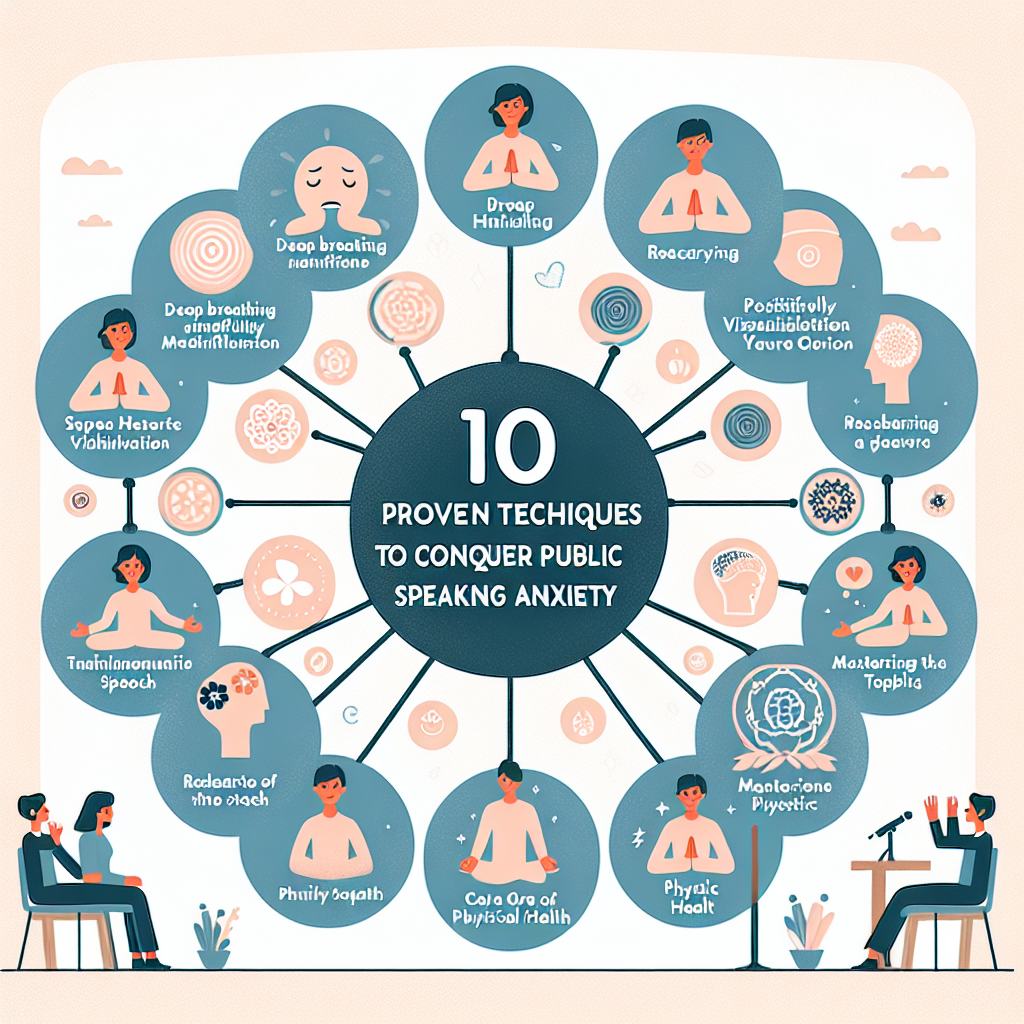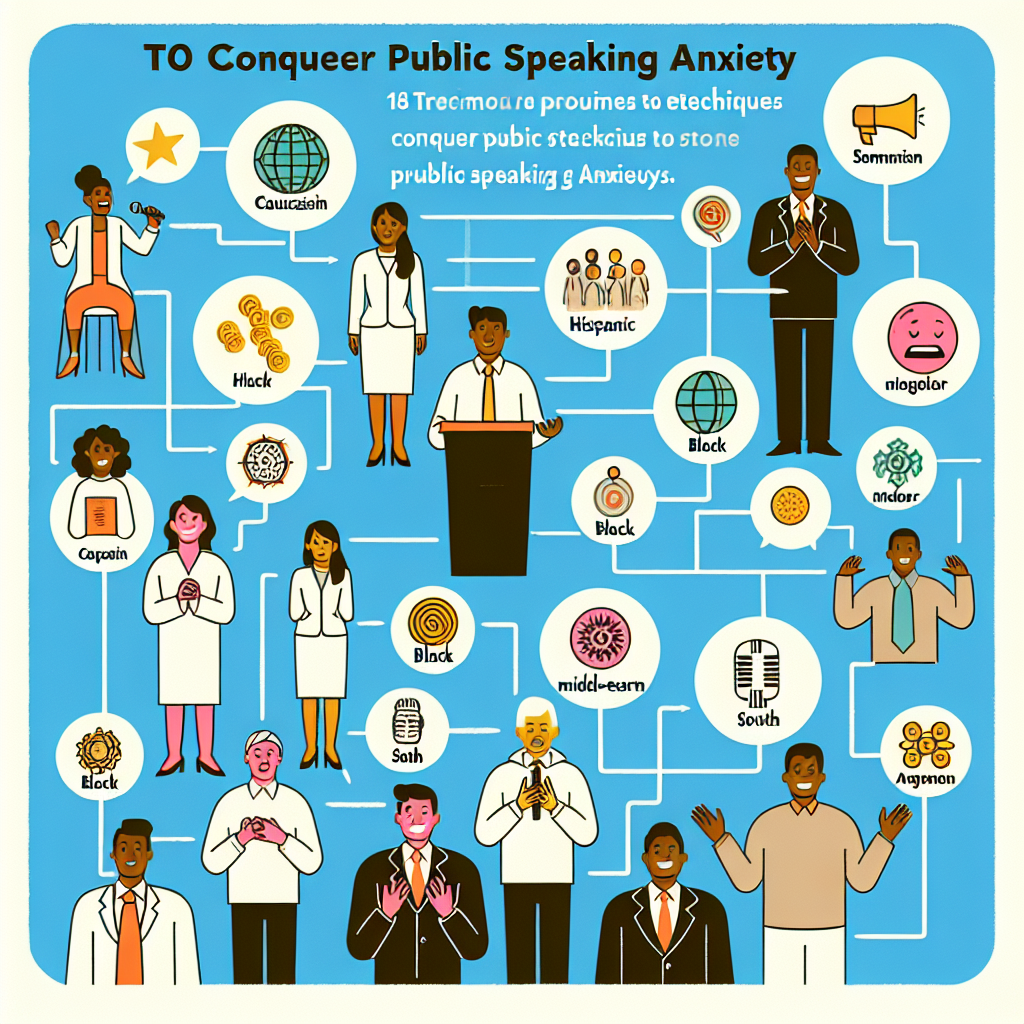-
Table of Contents
10 Proven Techniques to Conquer Public Speaking Anxiety
Public speaking anxiety is a common fear that affects many individuals, hindering their ability to effectively communicate in front of an audience. However, there are proven techniques that can help conquer this anxiety and improve public speaking skills. In this article, we will explore ten such techniques that have been tried and tested, providing individuals with the tools they need to overcome their fear and deliver confident and impactful presentations.
Understanding the Root Causes of Public Speaking Anxiety
One of the main reasons why people experience public speaking anxiety is the fear of judgment. The fear of being criticized or ridiculed by others can be overwhelming. This fear often stems from a lack of self-confidence and a fear of failure. By understanding that everyone makes mistakes and that it is a natural part of the learning process, individuals can begin to overcome this fear.
Another common cause of public speaking anxiety is the fear of forgetting what to say. Many individuals worry about blanking out or not being able to find the right words during a presentation. To combat this fear, it is important to thoroughly prepare and practice. By rehearsing the presentation multiple times, individuals can build confidence in their ability to remember and deliver the content effectively.
Additionally, the fear of being the center of attention can contribute to public speaking anxiety. Some individuals feel uncomfortable with all eyes on them, which can lead to feelings of self-consciousness and nervousness. To overcome this fear, it can be helpful to shift the focus from oneself to the audience. By focusing on delivering value and engaging the audience, individuals can redirect their attention away from their own anxiety.
Another root cause of public speaking anxiety is the fear of being unprepared. Feeling unprepared can lead to increased anxiety and a lack of confidence. To combat this fear, it is important to thoroughly research and gather information about the topic. By becoming an expert on the subject matter, individuals can feel more confident in their ability to speak about it.
Furthermore, the fear of being judged based on appearance or body language can contribute to public speaking anxiety. Many individuals worry about how they will be perceived by the audience, which can lead to self-consciousness and anxiety. To overcome this fear, it is important to practice good posture, maintain eye contact, and use confident body language. By appearing confident, individuals can project a sense of authority and reduce anxiety.
Understanding the root causes of public speaking anxiety is essential in order to conquer it. By addressing the fear of judgment, the fear of forgetting what to say, the fear of being the center of attention, the fear of being unprepared, and the fear of being judged based on appearance or body language, individuals can begin to overcome their anxiety. By implementing these ten proven techniques, individuals can build confidence and become effective public speakers. Remember, public speaking is a skill that can be learned and improved upon with practice and perseverance.
Overcoming Fear through Visualization and Positive Thinking
Visualization is a powerful tool that can help you overcome your fear of public speaking. By visualizing yourself delivering a successful speech, you can train your mind to believe that you are capable of doing so. Close your eyes and imagine yourself standing confidently on a stage, speaking with clarity and conviction. Picture the audience engaged and responsive, nodding their heads in agreement. Visualize yourself feeling calm and composed, exuding confidence and authority.
Positive thinking is another technique that can help you overcome public speaking anxiety. Instead of focusing on your fears and doubts, shift your mindset to a more positive and empowering one. Remind yourself of your strengths and accomplishments. Tell yourself that you are capable of delivering a great speech and that you have valuable insights to share. Replace negative thoughts with positive affirmations such as “I am a confident and engaging speaker” or “I have the ability to captivate an audience.”
In addition to visualization and positive thinking, there are other strategies that can help you overcome public speaking anxiety. One technique is to practice deep breathing exercises. Deep breathing can help calm your nerves and reduce anxiety. Take slow, deep breaths in through your nose, hold for a few seconds, and then exhale slowly through your mouth. Repeat this process several times before and during your speech to help you stay calm and focused.
Another technique is to prepare and practice your speech thoroughly. The more prepared you are, the more confident you will feel. Practice in front of a mirror or with a friend to get feedback and make any necessary adjustments. Familiarize yourself with the content of your speech so that you can speak confidently and fluently. The more you practice, the more comfortable you will become with the material, which will help alleviate anxiety.
It is also important to remember that mistakes are a natural part of public speaking. Even the most experienced speakers make mistakes from time to time. Instead of dwelling on your mistakes, learn from them and use them as opportunities for growth. Accept that it is okay to make mistakes and that they do not define your abilities as a speaker. By adopting this mindset, you can overcome the fear of making mistakes and focus on delivering a confident and engaging speech.
Furthermore, it can be helpful to visualize the audience as supportive and receptive. Instead of viewing them as judgmental or critical, imagine them as a group of individuals who are genuinely interested in what you have to say. Visualize them nodding their heads, smiling, and applauding your speech. This positive visualization can help boost your confidence and reduce anxiety.
Utilizing Breathing Techniques to Calm Nerves
When we are anxious or nervous, our breathing tends to become shallow and rapid. This can further exacerbate our anxiety and make it difficult to speak clearly and confidently. By focusing on our breath and practicing deep breathing exercises, we can calm our nerves and regain control over our body and mind.
One simple breathing technique that can be used before and during a speech is diaphragmatic breathing. This technique involves breathing deeply into the diaphragm, rather than shallowly into the chest. To practice diaphragmatic breathing, start by sitting or standing in a comfortable position. Place one hand on your chest and the other hand on your abdomen. Take a slow, deep breath in through your nose, allowing your abdomen to rise as you fill your lungs with air. Exhale slowly through your mouth, feeling your abdomen fall as you release the breath. Repeat this process several times, focusing on the sensation of your breath and the rise and fall of your abdomen.
Another effective breathing technique is the 4-7-8 breathing method. This technique is based on the ancient practice of pranayama, which involves controlling the breath to calm the mind and body. To practice the 4-7-8 breathing method, start by sitting in a comfortable position and closing your eyes. Take a deep breath in through your nose for a count of four. Hold your breath for a count of seven. Exhale slowly through your mouth for a count of eight. Repeat this cycle three more times, focusing on the rhythm of your breath and the sensation of relaxation that comes with each exhale.
In addition to these specific breathing techniques, it is also important to incorporate mindfulness into your public speaking routine. Mindfulness involves being fully present in the moment and non-judgmentally observing your thoughts and feelings. By practicing mindfulness before and during a speech, you can reduce anxiety and increase your ability to focus and connect with your audience.
One way to incorporate mindfulness into your public speaking routine is to take a few moments before your speech to close your eyes and focus on your breath. Notice the sensation of the breath entering and leaving your body. Observe any thoughts or feelings that arise, without judgment or attachment. Allow yourself to fully experience the present moment, letting go of any worries or distractions.

Practicing and Rehearsing to Build Confidence
Practicing and rehearsing your speech is crucial for several reasons. Firstly, it helps you become familiar with the content and structure of your speech. By practicing, you can ensure that you know your material inside out, which will boost your confidence when delivering it to an audience. Additionally, rehearsing allows you to identify any areas that may need improvement or clarification. This gives you the opportunity to make necessary adjustments and refine your speech before the actual presentation.
To make the most out of your practice sessions, it is important to create a realistic environment that simulates the actual speaking situation. Find a quiet space where you can stand and deliver your speech as if you were in front of an audience. This will help you get used to the feeling of speaking in front of others and reduce anxiety when the time comes.
Another technique to conquer public speaking anxiety is to record yourself during practice sessions. This allows you to evaluate your performance objectively and identify areas for improvement. Pay attention to your body language, tone of voice, and overall delivery. Are you making eye contact? Are you speaking clearly and confidently? By analyzing your recordings, you can make necessary adjustments and work on areas that need improvement.
In addition to practicing alone, it is also beneficial to rehearse in front of a small group of trusted friends or family members. This provides an opportunity to receive feedback and constructive criticism. Ask them to pay attention to your delivery, body language, and overall presentation. Their input can help you identify blind spots and make necessary improvements.
When practicing and rehearsing, it is important to focus on the quality rather than the quantity of your practice sessions. Instead of mindlessly repeating your speech, aim for deliberate practice. This means focusing on specific areas that need improvement and working on them systematically. By breaking down your speech into smaller sections and practicing them individually, you can ensure that you are addressing any weaknesses and building confidence in those areas.
Furthermore, it is crucial to practice your speech out loud rather than just reading it silently. Speaking out loud helps you become comfortable with the sound of your own voice and the rhythm of your speech. It also allows you to practice your timing and pacing, which are important aspects of effective public speaking.
Lastly, remember to practice with a timer. This will help you manage your time effectively during the actual presentation. By practicing with a timer, you can ensure that you are not rushing through your speech or going over the allotted time. This will give you a sense of control and confidence when delivering your speech in front of an audience.
Conclusion
In conclusion, there are 10 proven techniques to conquer public speaking anxiety. These techniques include: preparing and practicing thoroughly, visualizing success, focusing on the audience, using relaxation techniques, reframing negative thoughts, adopting a confident posture, starting with smaller speaking engagements, seeking support from others, embracing mistakes as learning opportunities, and gradually exposing oneself to more challenging speaking situations. By implementing these techniques, individuals can effectively overcome their fear of public speaking and deliver confident and impactful presentations.
🎤 FAQs on Public Speaking Anxiety
1️⃣ How do I overcome my fear of public speaking?
The best way to overcome public speaking fear is through gradual exposure and practice. Start small — speak in front of a mirror, then a friend, then small groups. Use deep breathing, visualize success, and focus on your message, not the fear.
2️⃣ What causes public speaking anxiety?
Public speaking anxiety comes from fear of judgment, mistakes, or embarrassment. Your brain perceives speaking as a threat, triggering the fight-or-flight response. It’s psychological, but consistent exposure and preparation can rewire that response.
3️⃣ What is the 3-3-3 rule of anxiety?
The 3-3-3 rule helps ground you during anxiety:
👉 Name three things you see,
👉 Identify three sounds you hear,
👉 Move three body parts like fingers or shoulders.
It brings your focus to the present and calms racing thoughts before a speech.
4️⃣ What are the 5 P’s of public speaking?
The 5 P’s are Planning, Preparation, Practice, Performance, and Passion.
Plan your message, prepare your outline, practice delivery, perform confidently, and speak with passion — that’s how great speakers connect emotionally.
5️⃣ How can I calm my anxiety in public?
To calm anxiety, slow your breathing and relax your muscles. Ground yourself with a few deep inhales and focus on one friendly face in the audience. Use affirmations like, “I’m prepared, and I belong here.”
6️⃣ What are the 7 powerful speaking tips?
-
Know your audience.
-
Start with a story.
-
Keep eye contact.
-
Pause for impact.
-
Use confident posture.
-
Vary your tone and speed.
-
End with a memorable takeaway.
These habits build confidence and credibility.
7️⃣ What are the 3 V’s of public speaking?
The 3 V’s are Verbal (words you say), Vocal (how you say them), and Visual (your body language).
Audiences remember tone and gestures more than words — make all three consistent and authentic.
8️⃣ What are 10 successful public speaking tips?
-
Practice aloud daily.
-
Record and review yourself.
-
Learn to pause — silence builds power.
-
Smile naturally.
-
Dress with confidence.
-
Rehearse key points, not full scripts.
-
Use stories and humor.
-
Engage with your audience.
-
Manage breathing and pacing.
-
Reflect after every talk to improve.
Mystery From the Sky: The Buga Sphere Appears in Colombia
Oumuamua: The Mysterious Interstellar Visitor and the Cosmic Message in Prashyant Jha’s Song
Hz Frequency Generator- Free Online Tone Generator
Also Read- 👉
👉What is 7 Hz good for? A careful, evidence-based guide (with references)
👉Cymatics: From 2D Sand Patterns to 3D Sound Sculptures
👉 Hz Frequency Generator- Free Online Tone Generator
👉 What Frequencies Are Dangerous to Humans? Understanding Risks from Sound to Radiation
👉How to do a Cymatic Experiment
👉What is the science behind cymatics?
👉 NASA-Approved 30-Min Brain Boost
👉 What Is The Healing Power Of Sound Wave
👉 What does 528 hz do to the brain?
👉 The 7 Healing Frequencies: Unlocking the Power of Sound for Wellness
👉 The Sacred Science of Yantras: How Cymatics Validates Ancient Tantric Geometry
👉 Is 1111 a Lucky Number? A Deep Dive into Its Mystical, Numerological, and Cultural Significance
👉 Is 528 Hz Dangerous?
People Also Read
- 2030 A Doomsday According to Indian Texts or Misinterpretation?
- The Glory of Narasimha Bhagwan: An Exploration of Ancient Indian History
- Medusa and Mansa Devi: The Untold Myths Connecting Greek and Hindu Traditions
- “The Enigmatic Link Between the Bermuda Triangle and Hindu Mythology of Ramayan: Unveiling the Mystery”
- why is mt. Kailash Considered to be a Sacred Site?
- How Eastern Wisdom Can Transform Your Modern Life.
- Lord Shani and Lord Yam : God of Karma for Living and Death
- In which direction Ganesh Idol should face.
- What is the logic for existence of God?
- Who Is Mahadev Shiv ?
- How to increase love for Krishna?
- Hanuman Chalisa English Lyrics| Bhajle Ram Naam | Prashyant Jha
Free AI Tools To test yourself
- Love Percentage Checker Tool – Check For Free!
- Soulmates Initial Finder
- Hz Frequency Generator- Free Online Tone Generator
- Mental Health Check In Tool [ FREE TEST ]
- Best Free Phone Photos Download
- Image Converter (Online & Free)
Seotoolrank.com Free Ai Tools
- RankVortex – Implies pulling traffic and SEO rankings toward you.
- How do I convert a PNG file to BMP?
- ConvertEase PDF
- Website Speed Checker Tool
- SEO Word Counter with Character Count
- Free Stopwatch and Online Timer Countdown
- Age Calculator Tool
- Password Generator Tool
- Qr Code Generator Free
- AI Story Generator Tool
- Blog Title Generator Tool [FREE]


